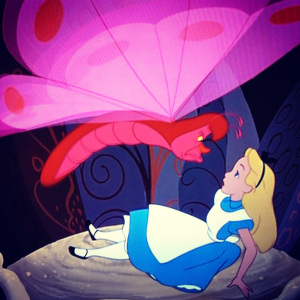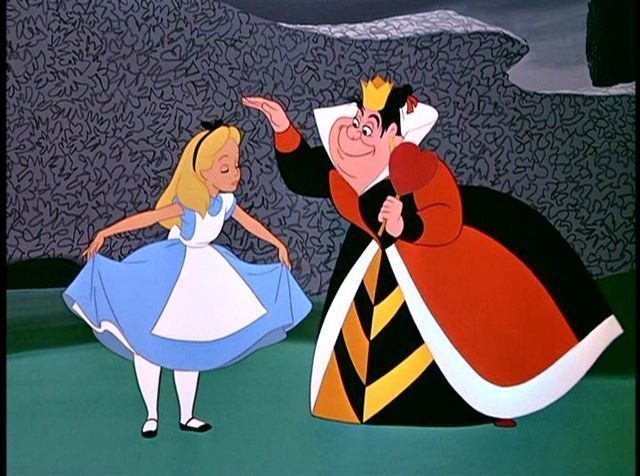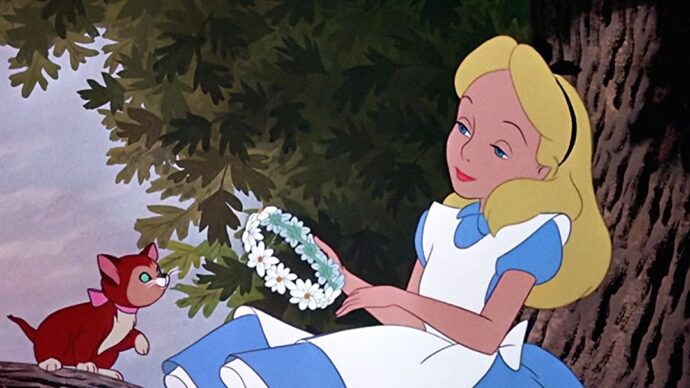Plus or Minus is a series detailing and analyzing every feature film now streaming on Disney+. It combines the unique history all these films share, their cultural impacts, and their qualities, or lack thereof. From timeless classics, to acquired hits, to DCOMs, no stone will be left unturned.
This next Plus or Minus, Alice in Wonderland, returns to the world of animation. Alice, voiced by Kathryn Beaumont, is a young, curious girl with her head in the clouds. She sees little need to listen to her sister, who is trying to teach her about the world and put some sense into her. In fact, she wishes to be far away from anything that makes sense. A world of her own to be exact. Specifically, a world where nothing makes sense. There’s no logic, no reason, and nothing grounding it from reality. And soon, Alice gets her wish.
A white rabbit, dressed in a coat and carrying a watch, suddenly appears, rushing to get some event. Curious, Alice follows the rabbit, but this soon leads to danger. After following the White Rabbit a bit too far, she falls into a rabbit hole and ends up in Wonderland, the very world of stuff and nonsense Alice dreamed of. As Alice continues to chase the rabbit, this young girl meets a slew of bizarre characters, each one crazier than the other. As such, Alice goes into one surreal adventure, with one bizarre event happening after another.
Humble Beginnings
While everybody knows about this classic Disney title, what some may not know is that the timeless Lewis Carroll story has been a fixture at Disney since the beginning.
Back in the 1920s, when Walt Disney was still a young, bright-eyed animator, he created a short series known as the Alice Comedies. Their most unique aspect was the blending of live-action and animation. A little girl was interacting with cartoon characters in an almost seamless fashion, giving it a unique angle compared to the likes of Felix the Cat.
After Walt moved to Hollywood, Alice in Wonderland was one of the first films he planned. There was even plans for an animated/live-action hybrid with actress Mary Pickford as Alice. This version was not to be, as Paramount released a similar Alice movie in 1933 and was a box office flop. And while the team tried to make the movie happen in the 1930s and 1940s, production was stalled again and again. In the end, the film we know today began production in 1946, becoming an all-animated feature film.
A Hidden Gem
Another thing people may not know about Alice in Wonderland was that it was a dud on its release. Not only did the film earn poor reviews, especially from UK critics and Carroll fans, but it was also a box office failure. The film gave Walt Disney Productions a million-dollar loss, with Walt Disney stating both its poor reception and lack of heart made the film suffer. According to film and Disney historian Leonard Maltin, animator Ward Kimball explained the issue pretty bluntly: “it suffered from too many cooks—directors. Here was a case of five directors each trying to top the other guy and make his sequence the biggest and craziest in the show. This had a self-canceling effect on the final product.”
And for a while, Alice was the black sheep of Disney. It never got a theatrical re-release during Walt’s lifetime. The only way people could catch it was on television, albeit severely edited and cut down. And while it did have its own ride, the Mad Tea Party, on Disneyland’s opening day, the film was just overshadowed by the more iconic Disney characters.
It wasn’t until the 1970s the film saw re-evaluation. In the era of psychedelia and drugs, Alice in Wonderland saw major attention from college students. Specifically hippie college students. And after sold-out rentals on campuses, the movie finally saw a re-release in 1974. With trippy visuals now more accepted, Alice in Wonderland was a hit in 1974 and was later regarded as a classic. Many argue while not the most faithful adaptation, it’s the strongest Alice in Wonderland movie ever made. And since then, the film has been an iconic Disney staple. It’s seen several rides at the parks, has several video releases, and makes millions in merchandise even today.

A Series of Vignettes
The big reason why folks back in 1951 didn’t latch onto this piece, I feel, is its structure. While there is a loose plot, the story is not the focus. Rather, the focus is Alice meeting an eccentric character or finding herself in a silly situation, then moving on to the next strange thing. None of these moments really go together until the end, creating a stream of consciousness style of movie. It’s a film that prides itself on weird characters, wild designs and incessant lunacy rather than the emotional storytelling Walt Disney Productions is famous for.
There’s also the issue that there is little in the way of story themes. There is a basic moral of “be careful what you wish for” in here, but it’s only barely touched upon. There’s little in terms of depth, emotional or intellectual, and that can be a deterrent. It is true that Disney protagonists are hardly the most layered or complex heroes. However, films like Pinocchio and Cinderella pride themselves on a strong central hero to root for. Movies like Snow White and Dumbo have a strong emotional center that makes it easy to get invested into the story. Apart from one scene before the climax, there’s nothing for people to latch onto story-wise.
However, this is not a problem I have with Alice in Wonderland. Plus or Minus is both a review series and a historical lookback. Therefore, I think it’s important to understand why certain movies didn’t get the critical love they later received. And to be perfectly honest, the lack of story and focus on madness is what makes Alice in Wonderland such a blast to watch in 2021.
Animation Showcase
One of the best things about the animation medium is character design and animation. Just seeing talented artists create distinct characters with unique movements, appearance, and style is just a treat. For Alice in Wonderland, the film prides itself on its fun, quirky designs. The backgrounds are full of life and energy, with distinct colors, lighting, and shadows that sets the right tone, mood, and atmosphere. However, it’s the characters and their looks that really pop here. Every design is memorable, madcap, and hilarious. The Cheshire Cat and Queen of Hearts in particular are the strongest. All the while, the character animation is on point throughout. There’s a lot of zippy, fast-paced movements which perfectly contrast with the more reserved look for Alice.
It’s just delightful to see all these wacky creatures play off one another and create mischief, and the animators know how to pull this off expertly. Perhaps the finest moment comes from the Mad Hatter’s tea party. Both the Hatter and the March Hare talk a mile a minute, go through fits of giddiness and pure panic in a millisecond, and have a delightful spastic energy that keeps you laughing. Of course helped also by Alice’s confused and irritated reactions and the fantastic voice performances from both Ed Wynn as the Hatter and Jerry Collonna as the March Hare.
Outside of the supporting cast, even the weird creatures that only flash by on the screen for a second are immensely detailed and fun to look at. The visual eye candy really does pop and make this a fun experience.
A Murderer’s Row of Crazies
The one aspect everybody remembers from this movie is the supporting cast. The strange figures who look to torment and confuse Alice on her quest for the White Rabbit. Everybody in this movie leaves a strong impression. Thanks not just to the strong voice acting, but also to the incredible craft of the animators. The talking doorknob is hilarious, while Tweedledee and Tweedledum bring a humorous story into the fray. The set of flowers deliver one of the more memorable tunes and the Caterpillar has a bizarre interaction.

Of course the real scene stealers pop up near the end. There’s the Cheshire Cat, whose devilish smile and pitch-perfect voice performance from Sterling Holloway creates a freaky, surreal figure. There are the Mad Hatter and March Hare, two insane kooks that are funnier and funnier the longer they go insane. However, the strongest one of them all is the Queen of Hearts. Essentially a whiny brat in a grown woman’s body, the Queen has a great design and delivers the strongest laughs. This also leads to an absolutely stellar climax. Everything from a bizarre game of croquet to a nonsensical trial to a topsy-turvy chase across Wonderland, it’s an absolute riot.
Curiouser and Curioser
Between all the insanity, the anchor is Alice herself. As is somewhat common with Disney protagonists at the time, Alice is a bit of a blank slate. She’s generally nice and polite and is more a surrogate for audiences to react to all the lunacy. With all that said of course, she’s still an effective lead. You do feel sorry for her, you understand her problems, and you want her to succeed at the end. This is also helped by Kathryn Beaumont’s performance. Beaumont gives her just enough innocence and even a hint of sarcasm to really make her character pop, making the film more fun.
The only real downside with Alice is, at times, how cruel the movie treats her. By all accounts, this is still a story about a girl who is getting attacked and harassed by weirdos for no reason. At points this can get really frustrating and uncomfortable. This is probably the one issue people will be split on with this movie. On one hand, the other characters are hilarious and the way Alice gets more frustrated is admittedly funny. Helps also Alice is a blank slate, so we are the ones in her shoes. On the other, it can be obnoxious at best or mean-spirited at worst. Personally speaking, it was a bit uncomfortable to see Alice get mistreated for little reason. However, I feel there’s just enough wit and cleverness here to distract from this one odd detail.
Plus or Minus?
Alice in Wonderland is a very solid release. While there are many distracting elements and its nonsensical plot won’t be everyone’s cup of tea, this excels as an animation showcase. There’s a lot of fun visuals and the characters are frequently humorous. It’s a joy to watch and it makes sense why it has a following decades later. Between Plus or Minus, Alice in Wonderland gets a very strong Plus.
NEXT TIME: Before the fox, Disney produced The Story of Robin Hood, a live-action piece. Does it have the right stuff for a Plus? Or is it a swing and a miss of a Minus?
